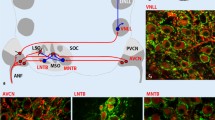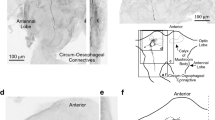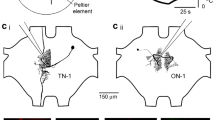Summary
-
1.
The neuronal pathways responsible for the cerecl-mediated inhibition of three cricket giant sensory interneurons were investigated.
-
2.
Two interneurons which had not previously been studied in detail were found to be influenced markedly by inhibitory inputs. Sensory interneuron 10-3 (SI 10-3) received excitatory synaptic input from longitudinally vibrating sound receptive hairs (L-hairs) on the cercus contralateral, and transversely vibrating hairs (T-hairs) on the cercus ispilateral to its axon. It was inhibited by contralateral T-hairs and ipsilateral L-hairs (Figs. 3 and 4). This pattern of receptor inputs imparts directional sensitivity upon SI 10-3. The inhibitory inputs increased the intensity range over which this directionality was observed (Figs. 4 and 5). SI 10-2 was also directionally selective and received similar cerecl inputs. The relative strength of inhibition, however, was much stronger. SI 10-2 was therefore primarily inhibited by sound (Fig. 6).
-
3.
The long latency of inhibition suggested that the pathway from cerecl receptors to the sensory interneurons was polysynaptic. The inhibitory potential could be reversed by injection of hyperpolarizing current (Fig. 7). Furthermore, the inhibitory pathway was capable of blocking action potentials produced by injection of current into the sensory interneurons (Fig. 8). The inhibition was therefore due, at least in part, to synapses impinging directly upon the sensory interneurons.
-
4.
The lateral giant interneuron (L.G.I.), also received cerecl inputs capable of producing an inhibitory postsynaptic conductance increase (Fig. 10). In addition, the cerecl receptor-to-giant interneuron pathway was inhibited presynaptically. The excitatory synaptic inputs from cerecl receptors to the L.G.I. were “protected” against decrement by prior activation of the inhibitory pathway (Figs. 12 and 13).
-
5.
Intracellular recordings from cerecl afferent axons revealed a primary afferent depolarization (P.A.D.), in response to activation of the cerecl receptors responsible for inhibition (Fig. 14). The latency of the P.A.D. suggested that the pathway involved was indirect. Action potentials occurring in the afferent axon during the P.A.D. had a reduced base-to-peak amplitude (Fig. 14).
Similar content being viewed by others
Abbreviations
- L.G.I. :
-
lateral giant interneuron
- SI 10-2 andSI 10-3 :
-
sensory interneurons 10-2 and 10-3
- P.A.D. :
-
primary afferent depolarization
References
Bacon, J.P., Altman, J.S.: A silver intensification method for cobalt filled neurons in whole mount preparations. Brain Res.138, 359 (1977)
Belosky, D.C., Delcomyn, F.: Information processing in a cricket ganglion: The response of giant fibres to sound pulses. J. Insect Physiol.23, 359–365 (1977)
Bryan, J.S., Krasne, F.B.: Protection from habituation of the crayfish lateral giant fibre escape response. J. Physiol.271, 351–368 (1977a)
Bryan, J.S., Krasne, F.B.: Presynaptic inhibition: The mechanism of protection from habituation of the crayfish lateral giant fibre escape response. J. Physiol.271, 369–390 (1977b)
Eccles, J.C.: The physiology of synapses. Berlin, Heidelberg, New York: Springer 1974
Edwards, J.S., Palka, J.: The cerci and abdominal giant fibres of the house cricket,Acheta domesticus, I. Anatomy and physiology of normal adults. Proc. R. Soc. London, Ser. B185, 83–103 (1974)
Fraser-Rowell, C.H., O'Shea, M., Williams, J.L.D.: The neuronal basis of a sensory analyser, the acridid movement detector system. IV. The preference for small field stimuli. J. Exp. Biol.68, 157–185 (1977)
Hoyle, G., Burrows, M.: Neural mechansim underlying behavior in the locustSchistocerca gregaria. I. Physiology of identified neurons in the metathoracic ganglion. J. Neurobiol.4, 3–41 (1973)
Kennedy, D., Calabrese, R.L., Wine, J.J.: Presynaptic inhibition: primary afferent depolarization in crayfish neurons. Science186, 451–454 (1974)
Krasne, F.B., Bryan, J.: Habituation: Regulation via presynaptic inhibition. Science182, 590–592 (1973)
Krasne, F.B., Wine, J.J., Kramer, A.: The control of crayfish escape behavior. In: Identified neurons and behavior of arthropods. Hoyle, G. (ed.). New York: Plenum 1977
Levine, R.B., Murphey, R.K.: Loss of inhibitory synaptic input to cricket sensory interneurons as a consequence of partial deafferentation. J. Neurophysiol. (in press).
Matsumoto, S.G., Murphey, R.K.: Sensory deprivation during development decreases the responsiveness of cricket giant interneurons. J. Physiol.268, 533–548 (1977a)
Matsumoto, S.G., Murphey, R.K.: The cercus-to-giant interneuron system of crickets. IV. Patterns of connectivity between receptors and the medial giant interneuron. J. Comp. Physiol.119, 319–330 (1977b)
Matsumoto, S.G., Murphey, R.K.: Sensory deprivation in the cricket nervous system: Evidence for a critical period. J. Physiol.285, 159–170 (1979)
Mendenhall, B., Murphey, R.K.: The morphology of cricket giant interneurons. J. Neurobiol.5, 565–580 (1974)
Murphey, R.K.: Characterization of an insect neuron which cannot be visualized in situ. In: Intracellular staining in neurobiology. Kater, S.B., Nicholsen, C. (eds.), pp. 135–150. Berlin, Heidelberg, New York: Springer 1973
Murphey, R.K., Levine, R.B.: Mechanisms responsible for the changes observed in the response properties of partially deafferented insect interneurons. J. Neurophysiol. (in press)
Murphey, R.K., Palka, J.: Efferent control of cricket giant fibres. Nature248, 249–251 (1974)
Murphey, R.K., Matsumoto, S.G., Mendenhall, B.: Recovery from deafferentation by cricket interneurons after reinnervation by their peripheral field. J. Comp. Neurol.169, 335–346 (1976)
Murphey, R.K., Palka, J., Hustert, R.: The cercus-to-giant system of crickets. II. Response characteristics of two giant interneurons. J. Comp. Physiol.119, 285–300 (1977)
O'Shea, M., Rowell, C.H.F.: Protection from habituation by lateral inhibition. Nature254, 53–55 (1975)
Palka, J.: An inhibitory process influencing visual responses in a fibre of the ventral cord of locusts. J. Insect Physiol.13, 235–248 (1967)
Palka, J.: Discrimination between movements of eye and object by visual interneurons of crickets. J. Exp. Biol.50, 723–732 (1969)
Palka, J., Olberg, R.: The-cercus-to-giant interneuron system of crickets. III. Receptive field organization. J. Comp. Physiol.119, 301–317 (1977)
Palka, J., Levine, R., Schubiger, M.: The cercus-to-giant interneuron system of crickets. I. Some attributes of the sensory cells. J. Comp. Physiol.119, 267–283 (1977)
Pitman, R., Tweedle, C., Cohen, M.: Branching of central neurons: Intracellular cobalt injection for light and electron microscopy. Science176, 412 (1972)
Wiese, K., Calabrese, R.L., Kennedy, D.: Integration of directional mechanosensory input by crayfish interneurons. J. Neurophysiol.39, 834–843 (1976)
Author information
Authors and Affiliations
Additional information
It was concluded that the excitatory pathway between cerecl afferents and the sensory interneurons is inhibited both pre- and postsynaptically.
Drs. C. Edwards, H.V.B. Hirsch, J. Jacklet, S.G. Matsumoto and J. Truman provided helpful comments on an earlier draft of this paper. Rober Speck helped prepare the photography. Supported by N.S.F. research grant no. BNS4523454 to R.K.M.
Rights and permissions
About this article
Cite this article
Levine, R.B., Murphey, R.K. Pre- and postsynaptic inhibition of identified giant interneurons in the cricket (Acheta domesticus). J. Comp. Physiol. 135, 269–282 (1980). https://doi.org/10.1007/BF00657255
Accepted:
Issue Date:
DOI: https://doi.org/10.1007/BF00657255




